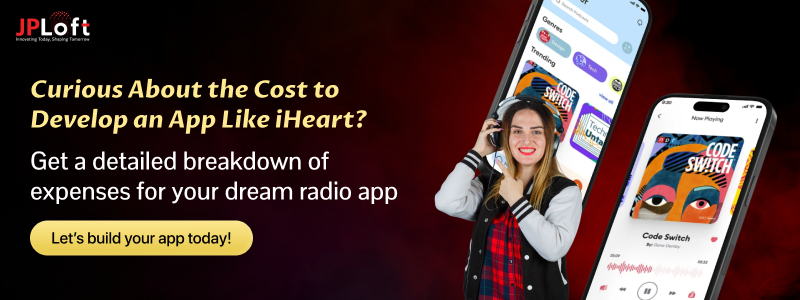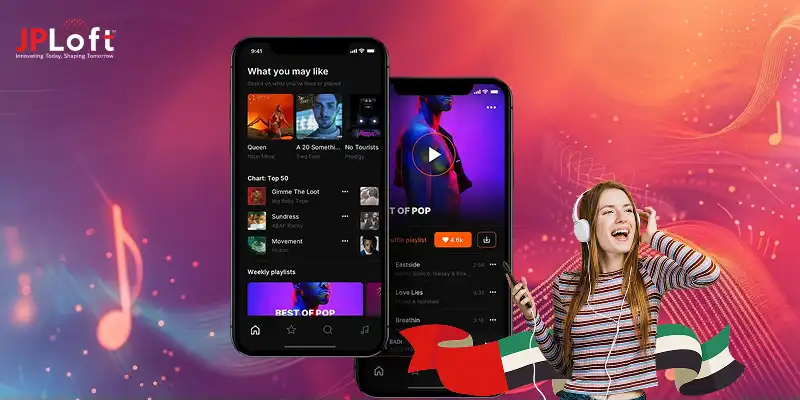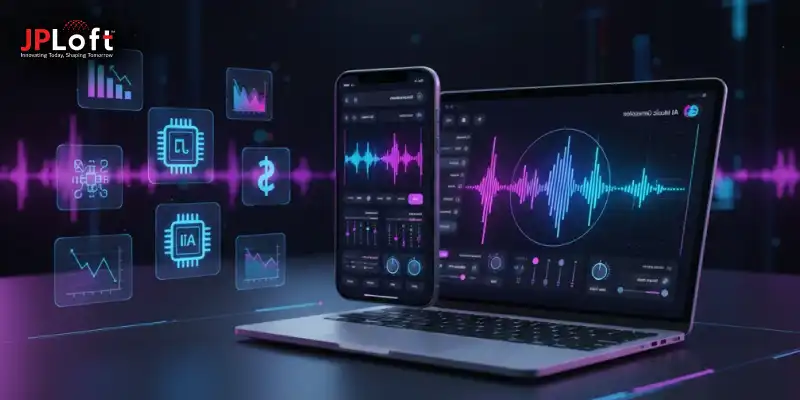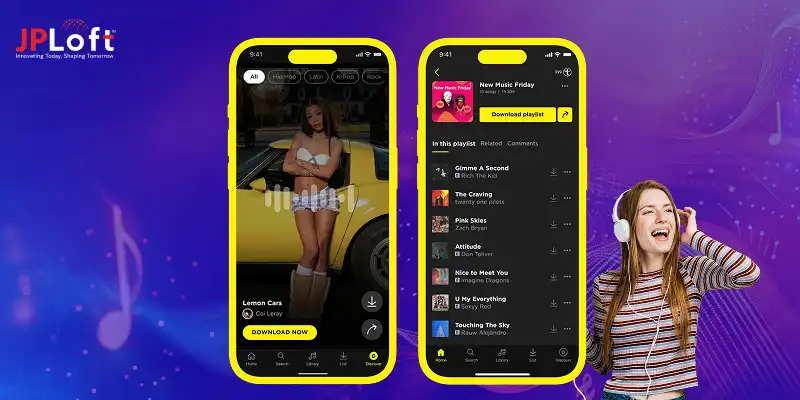Key Takeaways
The cost to develop a music streaming app like iHeart typically ranges between $20,000- $150,000+, depending on design complexity, features, and technology stack.
iHeart combines live radio, music streaming, and podcasts in one platform, offering global accessibility and AI-powered recommendations for a personalized user experience.
Factors influencing the cost are the app design, features, AI integration, backend infrastructure, and region of development, which impact the overall iHeart-like app development cost.
To reduce the cost, start with an MVP, use cross-platform frameworks, outsource to the right region, and leverage pre-built APIs to optimize budget without compromising performance.
Monetization models include freemium, subscriptions, ads, and partnerships to generate sustainable revenue and boost long-term profitability.
Did you know the global music streaming market is projected to surpass $110 billion by 2032, growing faster than ever before
Platforms like iHeart are leading this digital wave, offering not just music, but live radio, podcasts, and personalized audio experiences all in one app.
Imagine building something similar, a platform that connects millions of listeners with the sounds they love.
But before diving into development, the big question arises: how much does it cost to develop an app like iHeart?
The answer usually ranges between $20,000–$150,000, depending on features, design complexity, and technology stack.
In this blog, we’ll uncover the pricing factors, must-have features, and smart strategies to help you plan your own iHeart-inspired app efficiently.
What Is an iHeart App? A Quick Overview
The iHeart app is one of the world’s most popular platforms for streaming radio, music, and podcasts, all in one place. It allows users to explore live radio stations, follow favorite artists, and discover trending podcasts effortlessly.
If you’re planning to build a music app like iHeart, here’s what makes it stand out:
-
All-in-One Audio Hub: Combines live radio, music playlists, and podcasts under a single platform.
-
Personalized Experience: Uses smart algorithms to recommend stations and tracks based on user preferences.
-
Podcast Integration: Hosts thousands of top-rated podcasts across genres.
-
Global Accessibility: Streams over 850+ radio stations worldwide.
-
Multi-Device Support: Works seamlessly across smartphones, tablets, smart TVs, and wearables.
In short, iHeart isn’t just a streaming service; it’s a complete digital audio ecosystem that inspires developers to build a music streaming app with similar versatility and engagement.
How Much Does It Cost to Build an App Like iHeart?
One of the most common questions businesses ask is “What is the music streaming app development cost?” The answer isn’t one-size-fits-all. It largely depends on various factors such as app features, design complexity, backend infrastructure, technology stack, and the platforms you want to target (iOS, Android, or both).
If you’re planning to start small, you can launch a Minimum Viable Product (MVP) version with essential music streaming and radio functionalities.
However, if your goal is to create a full-fledged, feature-rich platform like iHeart that includes podcast integration, live radio, AI-based recommendations, and user personalization, the cost naturally rises.
On average, the cost to build an app like iHeart ranges between $20,000 - $150,000+, depending on your project’s scale, region of development, and feature set. The more advanced your app, the higher the investment, but also the greater the potential to attract and retain users worldwide.
|
App Type |
Development Cost (Approx.) |
Description |
|
Basic MVP App |
$20,000 – $40,000 |
Essential music streaming and radio features. |
|
Mid-Level App |
$40,000 – $90,000 |
Includes podcast hosting, personalization, and analytics. |
|
Advanced App |
$90,000 – $150,000+ |
Full-fledged platform with AI, offline mode, and cross-device syncing. |
Ultimately, your app development cost depends on the level of functionality and customization you aim for. Investing wisely ensures a feature-rich, high-performing app that stands strong in the competitive audio streaming market.
The right balance of technology and creativity can turn your app into the next big name in digital audio entertainment.
Factors That Influence the Cost to Develop an App Like iHeart
Understanding the cost to develop an app like iHeart requires more than just numbers; it’s about knowing what truly drives those costs. From features and design to AI integration and backend systems, each element plays a role in shaping your overall budget.
Below is a detailed breakdown of all the major factors influencing the cost and how they impact your timeline and investment.
1. App Features & Functionalities
Top music app features form the core of your platform. The more advanced your features, the higher your iHeart-like app development cost.
A simple app with basic streaming, playlist creation, and login options costs much less compared to a fully-fledged platform that supports AI-based recommendations, offline listening, podcasts, and live radio.
When estimating how much does it cost to create an app like iHeart, remember that advanced features require specialized developers, longer timelines, and complex integrations.
|
Cost-Affecting Factor |
Cost Impact |
Estimated Time |
|
Basic Features (Login, Music Player, Search) |
Medium |
4–6 weeks |
|
Advanced Features (AI, Offline, Podcast, Radio) |
High |
8–12 weeks |
|
Premium Subscriptions & Payment Gateway |
Medium–High |
6–8 weeks |
|
Smart Recommendations & Personalization |
High |
8–10 weeks |
2. App Design & User Experience (UI/UX)
Design is the first impression users get. A well-designed app builds trust, encourages engagement, and creates a premium feel. The cost to build a music streaming app like iHeart rises if you go for custom UI/UX design services like animations and brand-unique layouts.
A standard template-based design might save money but it won’t help you stand out among the top apps. Investing in modern visuals, motion effects, and intuitive navigation ensures your app looks and feels like a market leader.
Great design isn’t just about looks, it’s about crafting a seamless experience that keeps users listening longer and coming back for more.
|
Design Factor |
Cost Impact |
Estimated Time |
|
Basic UI with Standard Layouts |
Low |
3–4 weeks |
|
Custom UX with Animations & Branding |
High |
6–8 weeks |
|
Responsive Design (Multi-Device Support) |
Medium |
4–6 weeks |
|
Advanced Motion Graphics & Visual Effects |
High |
6–8 weeks |
3. Platform Choice (iOS, Android, or Both)
Your choice of platform plays a key role in the cost to make an app like iHeart. Building for one platform (iOS or Android) is more budget-friendly, while targeting both increases costs unless you use cross-platform technologies like Flutter or React Native.
If your target audience spans multiple devices, investing in cross-platform compatibility ensures better reach and long-term savings.
However, if you want a premium experience for Apple users, you can hire iOS developers to create a native, high-performing app tailored for iPhone and iPad. This approach often enhances performance, user satisfaction, and platform-specific design consistency.
|
Platform Option |
Cost Impact |
Estimated Time |
|
Single Platform (Android/iOS) |
Medium |
6–8 weeks |
|
Cross-Platform (Flutter/React Native) |
High |
8–12 weeks |
|
Native Apps for Both Platforms |
High |
10–14 weeks |
|
Web App (Browser-Based) |
Low–Medium |
4–6 weeks |
|
Smart Speaker & Wearable Integration |
High |
8–10 weeks |
4. App Tech Stack & Backend Infrastructure
The app technology stack determines the app’s performance, scalability, and stability. Using robust cloud servers, APIs, and databases increases reliability but also adds to the on-demand music streaming app cost like iHeart.
For instance, integrating cloud hosting (AWS, Azure), real-time streaming, and AI engines ensures smoother performance.
However, these advanced systems require experienced developers, affecting how much does iHeart cost to develop.
|
Tech Stack Element |
Cost Impact |
Estimated Time |
|
Basic Tech Stack (Standard Hosting & Player) |
Medium |
5–7 weeks |
|
Advanced Stack (CDN, Cloud Scalability) |
High |
8–10 weeks |
|
Database Setup (SQL/NoSQL) |
Medium–High |
3–5 weeks |
|
Third-Party API Integration (Login, Payment, Analytics) |
Medium |
2–4 weeks |
5. Music App Security
Security is one of the most overlooked yet vital aspects of music app development. Strong music app security measures protect your platform against piracy, data leaks, and unauthorized access.
The cost to make iHeart clone app increases with advanced protocols like DRM (Digital Rights Management), encryption, and secure payment gateways, but these are essential to maintaining credibility and compliance.
In a market where user trust defines success, investing in top-notch security ensures both your content and user data remain safe.
|
Security Measure |
Cost Impact |
Estimated Time |
|
Basic (SSL Encryption, Secure Login) |
Medium |
3–5 weeks |
|
Advanced (DRM, Payment Protection, MFA) |
High |
6–8 weeks |
|
Regular Security Audits |
Medium–High |
3–5 weeks (per cycle) |
|
Cloud Security & Data Backup |
Medium–High |
4–6 weeks |
6. AI, ML & Personalization Features
Artificial Intelligence plays a key role in building engaging, modern streaming platforms. Integrating AI in music streaming apps allows for smart recommendations, predictive search, and content personalization.
However, these technologies add complexity and increase the cost to create a streaming app like iHeart. Still, the investment pays off, AI-driven personalization not only boosts user retention but also enhances overall listening satisfaction.
By leveraging professional AI app development services, you can implement advanced features like mood-based playlists, voice-assisted navigation, and predictive analytics to deliver a truly next-gen listening experience.
|
AI/ML Feature |
Cost Impact |
Estimated Time |
|
Personalized Music & Podcast Suggestions |
Medium–High |
4–6 weeks |
|
Voice Search & Smart Playlists |
High |
6–8 weeks |
|
Predictive Analytics (User Behavior) |
High |
6–9 weeks |
|
Chatbots or Sentiment Analysis |
Medium–High |
5–7 weeks |
7. Region of Development & Team Size
The cost of development varies based on where your team is located. Hiring developers in regions like the U.S. or Europe increases the cost to create an app like iHeart, while teams in Asia offer high-quality work at affordable rates.
In addition to location, the size and expertise of your team also affect pricing, a small team may reduce costs but could slow down delivery, while a larger, specialized team ensures faster and more refined results.
Partnering with an experienced mobile app development company in Denver can help you strike the perfect balance between quality, budget, and communication efficiency.
|
Region |
Hourly Rate (Approx.) |
Impact on Cost |
|
United States |
$80 – $150/hr |
High |
|
Europe (UK, Germany) |
$60 – $130/hr |
High |
|
Australia |
$50 – $120/hr |
Medium–High |
|
India |
$25 – $50/hr |
Low–Medium |
|
Canada |
$50 – $110/hr |
Medium–High |
8. App Maintenance & Updates
Building your app is only the beginning, maintaining it is equally crucial. Regular updates, bug fixes, app maintenance service, and feature upgrades ensure long-term success.
When estimating the cost to create an app like iHeart, always include a 20–25% annual maintenance budget for stable performance and security. Ongoing maintenance not only keeps your app compatible with the latest OS versions and devices but also helps in improving user experience through continuous optimization.
Staying proactive with updates ensures your app remains relevant, secure, and competitive in the fast-changing digital music industry.
|
Maintenance Element |
Cost Impact |
Description |
|
Regular Updates & Bug Fixes |
Medium |
Keeps the app smooth and up-to-date |
|
Feature Upgrades & Scaling |
High |
Adds new features and improves capacity |
|
Cloud Hosting & Server Management |
High |
Ensures uninterrupted streaming |
|
User Support & Feedback Handling |
Medium |
Builds loyalty and trust |
|
Security Patches & Monitoring |
Medium–High |
Prevents data theft and vulnerabilities |
As discussed in the earlier, the cost to create an app like iHeart depends on numerous factors, from design and AI integration to backend architecture and maintenance. The key is to balance innovation with efficiency.
With careful planning, the cost becomes not just an expense, but a long-term investment in building a global, engaging, and future-ready music streaming experience.
Tips to Reduce the Overall Development Cost Like iHeart
Building a music streaming app that rivals iHeart doesn’t necessarily mean spending a fortune. With the right strategy and development approach, you can significantly lower the cost to develop an app like iHeart while still maintaining high performance and an exceptional user experience.
Here’s how you can do it smartly:
► Start with an MVP (Minimum Viable Product):
Begin your journey with an MVP focusing on core features like user registration, playlists, and playback. It’s a smart way to reduce the cost to make an app like iHeart while minimizing risk.
By choosing to build an MVP for a mobile app, you can test your idea, gather feedback, and refine your product before full-scale development.
► Use Cross-Platform Development Frameworks:
Frameworks such as Flutter or React Native enable you to build once and deploy across both Android and iOS. This saves time, effort, and almost 40% of development costs compared to creating separate native apps.
It’s an ideal approach for startups looking to lower their music streaming app development cost.
► Outsource Development to the Right Region:
Location plays a key role in pricing. Partnering with the best mobile app development company, you can give you a great balance between cost, communication, and quality.
This approach ensures access to expert-level coding and design talent at a fraction of the Western development cost.
► Leverage Pre-Built APIs & Cloud Solutions:
Instead of building every component from scratch, use pre-built APIs for authentication, payment gateways, and music recommendations.
Similarly, hosting your app on cloud platforms like AWS or Azure helps you scale affordably and reduces server management expenses, keeping the cost within budget.
► Focus on Core Features First:
Identify the top priorities, smooth streaming, easy navigation, and AI-driven recommendations. Avoid stuffing the app with unnecessary elements early on, as that’s one of the biggest reasons why music app fails to retain users and control costs.
Focusing on quality over quantity ensures a cleaner interface, faster performance, and a better first impression for your audience.
► Utilize Data-Driven Insights:
Analyze user behavior and listening patterns to understand which features are used most. Removing unused or redundant functions helps optimize your app, reducing load times, operational costs, and maintenance hours.
Data-driven optimization not only streamlines performance but also ensures you invest resources in features that truly enhance user satisfaction and engagement.
Reducing your iHeart-like app development cost isn’t about cutting corners, it’s about smart planning, phased development, and focusing on features that truly add value.
With the right balance of technology, design, and strategy, your app can stand among the best music streaming apps without breaking your budget.
Monetization Models for iHeart-Like App Development
To recover your investment and ensure long-term growth, you need smart ways to monetize a music streaming app. Here are some popular and effective monetization strategies used by top platforms like iHeart:
-
Freemium Model: Offer free access with limited features while encouraging users to upgrade to premium for an ad-free and enhanced experience.
-
Subscription Plans: Introduce tiered monthly or yearly plans that include offline listening, HD audio, and exclusive content.
-
In-App Advertising: Display targeted ads (audio, banner, or video) during free listening sessions to generate steady revenue.
-
Sponsored Playlists & Partnerships: Collaborate with brands and artists to feature their content or playlists for promotional fees.
-
Event & Merchandise Sales: Promote concert tickets, live shows, and artist merchandise directly within the app to boost profits.
A well-planned monetization strategy not only ensures consistent revenue but also enhances user engagement. Combining multiple models strategically can help your app remain profitable and competitive in the ever-evolving music streaming market.
Turn Your Music App Idea into Reality with JPLoft
Building a successful music app like iHeart or Spotify requires creativity, scalability, and technical precision and that’s where JPLoft excels. As a leading music app development company, we specialize in creating high-performance apps with stunning UI/UX, AI-driven recommendations, and real-time analytics.
Our expert developers deliver secure, feature-rich, and user-centric music platforms tailored to your business goals. From ideation to post-launch maintenance, JPLoft ensures your app stands out in a competitive market.
At JPLoft, we combine deep industry knowledge with next-gen tools to craft apps that engage users and scale effortlessly. Whether you want to launch a niche audio app or a global streaming platform, our team delivers end-to-end support to ensure your success.
Partner with us today to transform your idea into the next big name in music streaming.
Final Wrap-Up
Developing an iHeart-like app demands a mix of innovative design, flawless functionality, and strategic monetization. By understanding your users, integrating trending features, and working with the right team, you can create a platform that keeps listeners engaged for hours.
Whether you’re planning a freemium or subscription-based model, choosing the right partner is crucial for success.
The overall cost to develop an app like iHeart depends on your chosen features, technology stack, and development approach. With expert guidance and the right strategy, you can balance cost and quality effectively.
FAQs
The cost depends on app complexity, features, and platform choice. On average, it ranges between $30,000 to $150,000 for a full-featured music streaming app.
Typically, it takes 3–6 months depending on design, functionality, and testing requirements.
Popular tech stacks include React Native, Flutter, Node.js, Python, and AWS for scalable and real-time performance.
You can monetize through subscriptions, ads, sponsorships, and in-app purchases like event tickets or merchandise.
Core features include AI-driven recommendations, offline mode, playlists, social sharing, and high-quality audio streaming.













Share this blog